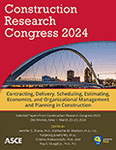Investigating Perception Variances among Project Participants Concerning the Challenges of Renovating Historic Buildings
Publication: Construction Research Congress 2024
ABSTRACT
The common goal of historic building renovation and restoration projects is to accommodate current needs while preserving the cultural and aesthetic heritage of buildings. However, the challenges encountered when renovating historic buildings are different from new construction projects. To provide better insights, the authors conducted a survey of industry practitioners to identify the frequency and severity of common challenges. Comparison of results by the respondents’ functional role shows a significant difference in assessing the severity of challenges, but no difference in assessing the frequency. Notably, construction team members tend to perceive the challenges as more frequent and severe than design professionals do. This study contributes to the body of knowledge in the risk management research domain as well as the historic renovation construction domain. Also, this study allows industry practitioners to better understand this type of construction project and manage plans by considering differences in their roles.
Get full access to this article
View all available purchase options and get full access to this chapter.
REFERENCES
Aigwi, I. E., Egbelakin, T., and Ingham, J. 2018. “Efficacy of adaptive reuse for the redevelopment of underutilised historical buildings: Towards the regeneration of New Zealand’s provincial town centres.” International Journal of Building Pathology and Adaptation, 36(4), 385–407. https://doi.org/10.1108/IJBPA-01-2018-0007.
Alba-Rodríguez, M. D., Martínez-Rocamora, A., González-Vallejo, P., Ferreira-Sánchez, A., and Marrero, M. 2017. “Building rehabilitation versus demolition and new construction: Economic and environmental assessment.” Environmental Impact Assessment Review, 66, 115–126. https://doi.org/10.1016/j.eiar.2017.06.002.
Altman, D. G. 1991. Practical statistics for medical research. London: Chapman & Hall. CRC, 396, 439.
Azizi, N. Z. M., Razak, A. A., Din, M. A. M., and Nasir, N. M. 2016. “Recurring issues in historic building conservation.” Procedia-Social and Behavioral Sciences, 222, 587–595. https://doi.org/10.1016/j.sbspro.2016.05.217.
Bullen, P., and Love, P. 2011. “A new future for the past: A model for adaptive reuse decision‐making.” Built Environment Project and Asset Management, 1(1), 32–44. https://doi.org/10.1108/20441241111143768.
Clark, J., and Wolkenberg, T. 2013. Adaptive reuse of industrial heritage: Opportunities & challenges. Melbourne: Heritage Council Victoria. https://heritagecouncil.vic.gov.au/wp-content/uploads/2014/08/HV_IPAWsinglepgs.pdf.
Conejos, S., Langston, C., Chan, E. H. W., and Chew, M. Y. L. 2016. “Governance of heritage buildings: Australian regulatory barriers to adaptive reuse.” Building Research & Information, 44(5-6), 507–519. https://doi.org/10.1080/09613218.2016.1156951.
Escamilla, E. 2011. Investigation of project management planning practices for renovation of historical buildings in urban contexts located in Texas. [Doctoral dissertation, Texas A&M University.] http://hdl.handle.net/1969.1/ETD-TAMU-2011-05-9272.
Havlicek, L. L., and Peterson, N. L. 1974. “Robustness of the t test: A guide for researchers on effect of violations of assumptions.” Psychological Reports, 34(3_suppl), 1095–1114.
Hein, M. F., and Houck, K. D. 2008. “Construction challenges of adaptive reuse of historical buildings in Europe.” International Journal of Construction Education and Research, 4(2), 115–131. https://doi.org/10.1080/15578770802229466.
Hettema, J., and Egberts, L. 2019. “Designing with maritime heritage: Adaptive re-use of small-scale shipyards in northwest Europe.” Journal of Cultural Heritage Management and Sustainable Development, 10(2), 130–143. https://doi.org/10.1108/JCHMSD-04-2019-0032.
Kelly, D., and Koo, H. J. 2023. Challenges completing large historic building renovations: Lessons learned from Detroit, Michigan. Pending re-review after resubmission.
Langston, C. 2014. Sustainable Building Adaptation: Innovations in Decision-making, John Wiley & Sons, https://doi.org/10.1002/9781118477151.ch12.
Langston, C., and Shen, L. Y. 2007. “Application of the adaptive reuse potential model in Hong Kong: A case study of Lui Seng Chun.” International Journal of Strategic Property Management, 11 (4), 193–207. https://doi.org//10.1080/1648715X.2007.9637569.
Noori, A., Saruwono, M., Adnan, H., and Rahmat, I. 2016. “Conflict, complexity, and uncertainty in building refurbishment projects.” In Proc., InCIEC 2015, 251–258, Springer Singapore. https://doi.org/10.1007/978-981-10-0155-0_24.
Olivadese, R., Remøy, H., Berizzi, C., and Hobma, F. 2017. “Reuse into housing: Italian and Dutch regulatory effects.” Property Management, 35(2), 165–180. https://doi.org/10.1108/PM-10-2015-0054.
Pintossi, N., Ikiz Kaya, D., and Roders, A. P. 2021. “Assessing cultural heritage adaptive reuse practices: Multi-scale challenges and solutions in Rijeka.” Sustainability, 13 (7), 3603. https://doi.org/10.3390/su13073603.
Rochon, J., Gondan, M., and Kieser, M. 2012. To test or not to test: Preliminary assessment of normality when comparing two independent samples. BMC medical research methodology, 12(1), 1–11.
Tan, Y., Shuai, C., and Wang, T. 2018. “Critical success factors (CSFs) for the adaptive reuse of industrial buildings in Hong Kong.” International Journal of Environmental Research and Public Health, 15(7), 1546. https://doi.org/10.3390/ijerph15071546.
Tuan, Y. F. 1977. Space and place: The perspective of experience. Minneapolis, MN: University of Minneapolis Press.
Vainio, T. H. 2011. “Building renovation: A new industry?” In Proc., Management and Innovation for a Sustainable Built Environment MISBE 2011, Amsterdam, The Netherlands, June 20-23, CIB, Working Commissions W55, W65, W89, W112; ENHR and AESP. http://resolver.tudelft.nl/uuid:2b173610-96e5-4031-b16f-8806268a8c4b.
Vrusho, B., and Pashako, F. 2017. “Adaptive reuse of underused industrial sites, case study: The superphosphate of Laç.” In Proc., Putting Tradition into Practice: Heritage, Place and Design: Proceedings of 5th INTBAU International Annual Event 5, 1097–1112. Springer International Publishing. https://doi.org/10.1007/978-3-319-57937-5_113.
Yung, E. H. K., and Chan, E. H. W. 2012. “Implementation challenges to the adaptive reuse of heritage buildings: Towards the goals of sustainable, low carbon cities.” Habitat International, 36(3), 352–361. https://doi.org/10.1016/j.habitatint.2011.11.001.
Zagorskas, J., Paliulis, G. M., Burinskiene, M., Venckauskaite, J., and Rasmussen, T. V. 2013. “Energetic refurbishment of historic brick buildings: Problems and opportunities.” Scientific Journal of Riga Technical University, Environmental and Climate Technologies, 12, 20–27. https://doi.org/10.2478/rtuect-2013-0012.
Information & Authors
Information
Published In
History
Published online: Mar 18, 2024
Authors
Metrics & Citations
Metrics
Citations
Download citation
If you have the appropriate software installed, you can download article citation data to the citation manager of your choice. Simply select your manager software from the list below and click Download.
